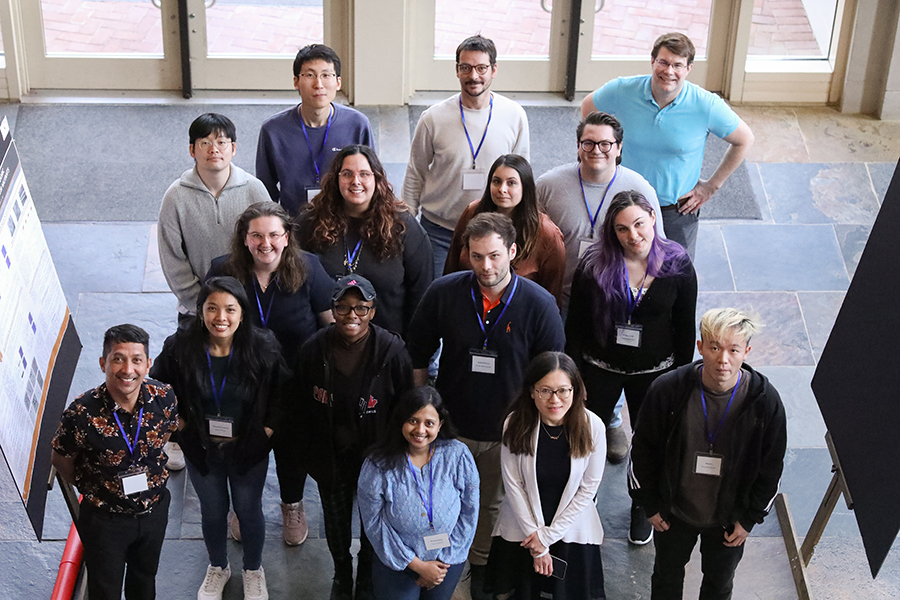Bleiholder lab hosts annual workshop to highlight experimental and computational methods for structural biology

Understanding viral spike proteins, the components of viruses including HIV-1 and SARS-CoV-2 that play a crucial role in how these invaders enter and infect a body’s cells, is among today’s most pressing challenges when it comes to developing therapeutic drugs for viral treatments and designing tomorrow’s vaccines.
Researchers from the Florida State University Department of Chemistry and Biochemistry’s Bleiholder Lab have developed cutting-edge experimental and computational methods that are advancing research in this crucial area. This week, the group hosted a dozen visiting scientists from across the U.S. for a multi-day workshop aimed at expanding use of these innovative techniques.
“The Spring Workshop, funded in part by the National Science Foundation and the FSU Office of Research, works to explain the methods developed in our laboratory, such as Tandem-TIMS, to the scientific community,” said associate professor of chemistry Christian Bleiholder. “Our lab is committed to pursuing interactions between early career researchers and students that will lead to collaborations between their labs, thus helping build a vibrant and collaborative ion mobility/mass spectrometry community.”
While there are currently available biophysical methods for studying spike proteins, including X-ray crystallography, a tool used for determining the atomic and molecular structure of a crystal, and cryo-electron microscopy, a mainstream technology for studying the architecture of cells, overall options are limited due to the coating of the proteins’ surface with sugar molecules.
According to Bleiholder, his research team developed Tandem-Trapped Ion Mobility Spectrometry in collaboration with the Bruker Corporation, an American manufacturer of scientific instruments for molecular and materials research, using funding from his NSF Early Career Development Program award. The Tandem-TIMS/MS method serves as a novel analytical instrument available to gather structural information of glycoproteins, including viral spike proteins.
Attendees to this year’s workshop included graduate students and postdoctoral scholars from Purdue University, University of Wisconsin Madison, Texas A&M University, University of Washington, University of Florida, Clemson University, Vanderbilt University, Auburn University, University of Tennessee Knoxville, and Wichita State University, as well as a high school science teacher from Orange County, Florida.
“The more we can share our work with the world, the more we believe the field of chemistry can grow collaboratively towards discoveries we never thought would be possible in an individual lab,” said Fanny Caroline Liu, a chemistry research faculty member. “This workshop gives us the opportunity to not only disseminate what our team has already established but also to learn from fellow researchers about how we can improve our techniques and gain fresh perspectives.”
The Bleiholder Lab is committed to outreach and the development of a stronger scientific community. This is the Spring Workshop’s third iteration, and its first in-person experience since the series’ founding in 2022. The lab’s 2023 Summer School on Computational Tools for Structural Interpretation of Ion Mobility Spectra highlighted tools used to investigate structural and functional relationships among complex biological materials. In addition to eight in-person participants from universities across the U.S., this hybrid event welcomed roughly 100 online participants from the U.S., United Kingdom, the Netherlands, Germany and other countries. This year's workshop included a virtual guest lecture by Ying Ge, professor of cell and regenerative biology and chemistry and renowned leader in proteomics at the University of Wisconsin-Madison.
Researchers in the Bleiholder lab continue to cultivate a culture of innovation and collaboration within both academia and scientific industry. Bleiholder, Liu, and two Bruker scientists are listed as co-inventors on a joint patent with the Bruker Corporation on Tandem-TIMS/MS in the U.S., Europe and China. The group also holds two patents of its own covering other computational methods, including Bleiholder’s Structure Relaxation Approximation method for studying protein structures. Several grants from NSF and the National Institutes of Health supported the development of their technologies.
The lab’s long-term goal is to reveal how variations in the chemical modifications of proteins affect their structures and interactions in human biological systems, endeavoring towards the development of more advanced vaccines and novel therapeutic interventions.
To learn more about the Bleiholder Laboratory’s research and chemistry at FSU, visit chem.fsu.edu.
